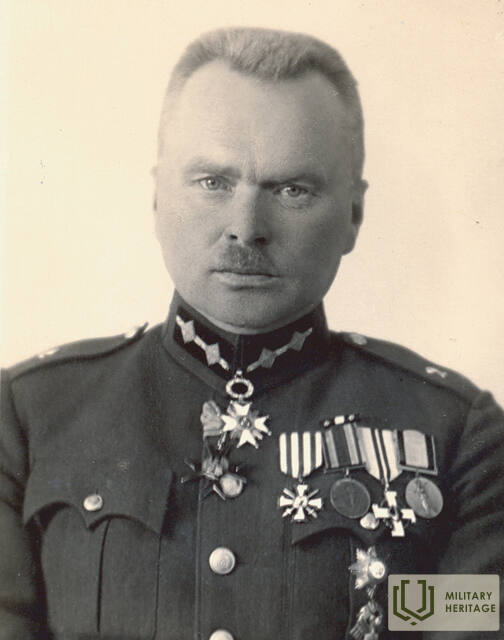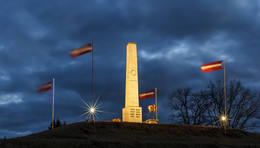Atminimo akimirka Garnizono kapinėse
Atkūrus Latvijos nepriklausomybę Alūksnės brolių kapinių komiteto vadovas Uldis Veldre prisiėmė atsakomybę už Garnizono kapinių priežiūrą, su Alūksne susijusių LKOK poilsio vietų nustatymą, atminimo ženklų įrengimą Įgulos kapinėse.
„Sužinojęs, kad V. Spandegs (1890-1941) mirė, 1990 m. gruodžio 19 d., sovietų okupacijos sąlygomis, Alūksnės įgulos kapinėse, prie didelio balto kryžiaus, rūpestingai surengiau jo 100-mečio minėjimą, atidengdama čia visada šviežią balto marmuro atminimo lentą red., ypatingai pažymime generolo V. Spandeg gimimo ir žūties datas - gruodžio 19 d., spalio 16 d. ir Lāčplės dieną - lapkričio 11 d. Tai buvo ir spalio 16 d., kai paminėjome Lāčplėčio Vilio Spandego 60-ąsias žūties metines, Garbės sargyba su Latvijos vėliava buvo RiūkSndegų kariai ir Braškų krašto gynėjai. E. Glik Alūksnės valstybinės gimnazijos vėliavnešiai 1938 m. vėliavą - 7-ojo Siguldos pėstininkų pulko dovaną Alūksnės valstybinei gimnazijai - įteikė Alūksnės Tėvynės meilės pamokos, mūsų tautinio didvyrio Vilačnėjaus brolio Cėdiškio komiteto. ne MSB, Lāčplēsis Eduards
Koklės anūkas Sandris, proanūkis Albertas ir proanūkė Adelė Līvini pasodino ąžuolą, kad amžinai išliktų šviesus paskutinio 7-ojo Siguldos pėstininkų pulko vado, Lāčplės kapo ordino kavalieriaus, tuometinio pulkininko Vilio Spandego, atminimas. Ąžuolą kartu su MSB vaikinais atsivežėme iš didžiojo latvio Zigfrido Kalačio žemės. Pasirinkimas nebuvo atsitiktinis. Ankstyvą 1919 m. pavasarį mūšiuose prie Rezakos, Jaunlaicenės ir Apės antrajam Valmieros pulko batalionui vadovavo mūsų vietinis (iš Gaujos) Kārlis Bojārs - Lāčplės karo ordino III laipsnio kavalierius, 7-ojo Siguldos pėstininkų pulko vadas1 Herūke's į Colk6 nemirti. Jie gyvens mūsų žmonių širdyse net tada, kai nebeliks mano kartos – tikrųjų Alūksnės ir Latvijos istorijos nešėjų prieš daugiau nei 60 metų. „Tegul niekada netrūksta didvyrių, galinčių ir norinčių atiduoti viską, ką turi savo tėvynei, šaliai ir žmonėms.
Vaizdo įrašas skirtas Viliui Spandegui atminti
Uldis Veldre, Alūksnės brolių kapinių komiteto vadovas. Alūksnė mini Vili Spandegą. Pakalbėkime apie Lāčplēši. Laisvoji Latvija: sujungtas „Londono laikraštis“ ir „Latvija“, 2001, lapkričio 10 d., Nr. 43.
https://www.youtube.com/watch?v=jtzCjhm80so
Susijusi laiko juosta
Susijusios vietos
Alūksne Garrison Cemetery
Located on the shores of Lake Alūksne, on the Kapsēta peninsula, in the territory of the Great Cemetery.
They were started and maintained by the soldiers of the 7th Sigulda Infantry Regiment in the 1930s and consecrated on November 11, 1932. After the restoration of Latvia's independence, Uldis Veldre, the head of the department of the Alūksne Brothers' Cemetery Committee, took care of the maintenance of the Garrison Cemetery, the identification of the resting places associated with Alūksne and the installation of memorials in the Garrison Cemetery.
Military personnel of the Army of the Republic of Latvia were buried in the garrison cemetery, as well as soldiers and civilians killed in the fight against the Bolsheviks on July 4, 1941 in Alūksne near Jāņkalniņš and on July 7, 1941 in Ziemera parish.
Most of the buried have white wooden crosses with metal plaques, which indicate the name of the deceased, the rank or occupation, as well as the date of birth and death.
On December 19, 1990, a memorial to Vilius Spandeg, a knight of the Lāčplēsis Military Order, was unveiled in the Garrison Cemetery. Standard memorial plaques were also erected to the LKOK, who died or were killed in communist concentration camps and were not buried in Latvia. On November 11, 1990, a memorial was erected to Voldemārs Zaķis, who died in the communist concentration camp.
Monument to the soldiers of the 7th Sigulda Infantry Regiment who died in the Latvian War of Independence
Located on the shores of Lake Alūksne, on the edge of Pleskavas Street (Kolberg Road).
On June 22, 1923, the President of Latvia, Jānis Čakste, unveiled a monument to the fallen soldiers of the 7th Sigulda Infantry Regiment. The monument is based on the design of the artist Jūlijs Miesnieks.
The soldiers of the regiment also improved and maintained the area around the monument. Soldiers gathered at the monument on the eve of the regiment's annual holiday, when the holy fire was lit, as well as on the day of the regiment's year after the parade and intercession in the garrison cemetery.
1940/1941 The Bolsheviks removed and destroyed the plaque in 1953, but the monument itself was demolished in 1953 and its stones were laid in the foundations of the corner of the barracks house.
At the beginning of the Awakening, in the autumn of 1989, the vicinity of the destroyed monument, which was still in the territory of the USSR occupation forces, was cleaned up. On November 11, a temporary granite memorial was unveiled at the former location of the monument, with the text: "The monument of the 7th Sigulda Infantry Regiment will be restored in this place on November 11, 1989."
Thanks to the initiative of U. Veldre, the head of the Alūksne Brothers Cemetery Committee, the restoration of the monument was started and on October 16, 2009 the restored monument was unveiled.
Unlike the original monument, a cross was created on the obelisk regiment instead of a chest sign. Both sculptures of the monument were wrought by the sculptor Ainars Zelcs. Both the part of the 22 original obelisk blocks found on the territory of the National Armed Forces Infantry School and the newly built blocks were used for the restored monument.
On June 20, 2019, as part of the centenary of the Sigulda Infantry Regiment, a memorial site and a granite memorial plaque to the fallen soldiers of the unit were unveiled at the foot of the monument hill. The memorial site was built with funds donated by the staff of the Infantry School of the National Armed Forces.







